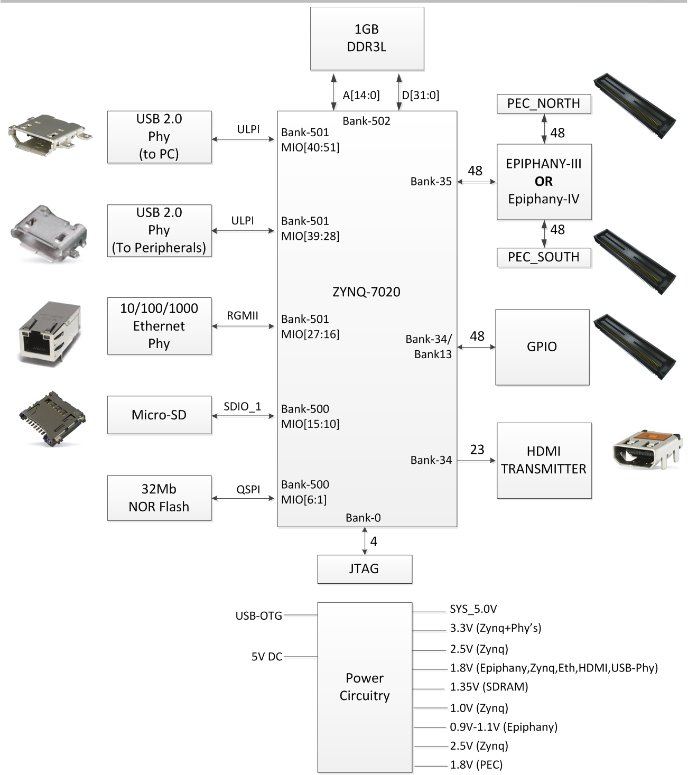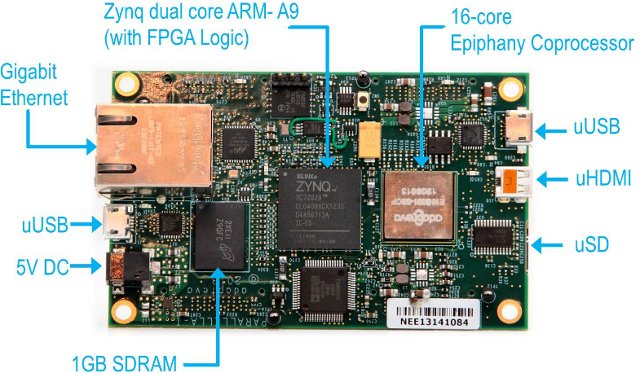Parallella is a low cost supercomputer designed by Adapteva using Xilinx Zynq-7010/7020 FPGA+2x Cortex A9 SoC combined with Adapteva Ephipany 16 or 64 cores epiphany coprocessor. The project had a successful kickstarter campaign which allowed then to provide the 16-core version for $99, and the 64-core version for $750. The board will soon be shipped to people who pledged on kickstarter, and one of the promise of the campaign was to fully open source the platform, and today, they just fulfilled that.
Before going into the details of the open source release, let’s have a look at the specs:
- SoC – Xilinx Zynq7000 Series (Z-7010 or Z-7020) Dual-Core ARM Cortex A9 with 512KB L2 Shared Cache
- Coprocessor – Epiphany Multicore Coprocessor. The Parallella-16 board includes the 16-core Epiphany-III processor The Parallella-64 board includes the 64-core Epiphany-IV processor
- System Memory – 1024MB DDR3L
- Boot Flash – 128 Mb QSPI Flash
- Indicators – 2 User controlled LEDs
- USB:
- USB 2.0 Port(0) Connects to a host machine (PC/tablet/smartphone)
- USB 2.0 Port (1) Connects peripheral devices
- Ethernet – 10/100/1000M Ethernet, RJ45 with magnetics and LEDs
- SD Connector – MicroSD, 3.3V
- Video – Micro HDMI connector
- Expansion Connectors – Four 60-pin high speed Samtec connectors for:
- Epiphany link expansion connector(s)
- Zynq programmable logic extension connector
- Power, JTAG, debug connector
- Power Source – USB or 5.0V DC
- PCB Dimensions – 86.36mm x 53.34mm

The 64-core version of the Parallella computer is said to deliver over 90 GFLOPS of performance, and have a processing equivalent to a 45 GHz CPU [64 CPU cores * 700MHz] providing you can run your application on the 64-core simultaneously on a tiny board consuming only 5 Watts under typical work loads. Imaging, communications, automotive, medical, and audio applications could take advantage of parallel computing at a much lower cost than is currently available with Parallella.
In order to make a platform really “open source hardware” you need to release the source code as well as the hardware file, and for the parallela platform everything seems now available on their github repository including:
- Parallella board design files with bill of materials, schematics (dsn and pdf), layout files (brd), and Solidworks files.
- Official u-boot for Parallella board
- Official linux kernel for Parallella
- Official Ubuntu distro for Parallella
- Sourceware Tree for Epiphany
- GCC for Epiphany
- SDK scripts for Epiphany
We’ve got the hardware files, u-boot and linux for Zynq EPP, and the software running on Adapteva coprocessor. I haven’t checked the details but it looks like they fulfilled their promise. You can also access a preliminary version of Parallella Reference Manual.
You can also find more documentation on parallella.org. If you’ve missed the kickstarter campaign, and need a platform for parallel computing, the Parallela boards do not seem available right now, but you can register on their website to be informed once they are up for sale again.

Jean-Luc started CNX Software in 2010 as a part-time endeavor, before quitting his job as a software engineering manager, and starting to write daily news, and reviews full time later in 2011.
Support CNX Software! Donate via cryptocurrencies, become a Patron on Patreon, or purchase goods on Amazon or Aliexpress






4*16 = 64, 4*$99 = $396 << $750…
so why the huge diseconomy of scale on the pricing for the 64 core version?
@onebir
Possibly CPU itself bumps up the cost.
@onebir
indeed, the apparent diseconomoy of scale is even worse: according http://en.wikipedia.org/wiki/Adapteva#Epiphany_multicore_Coprocessors, is 32 GFLOPS vs 102 only.
However, there is an logic explanation according that Wikipedia page:
“Raising $3 million goal was unsuccessful, so no 64-core version of Parallela will be mass produced. [12] Kickstarter users having donated more than $750 will get “parallela-64″ variant with 64-core coprocessor (made from initial prototype manufacturing with 50 chips yield per wafer).”
@onebir Kickstarter isn’t a shop, and so the “prices” aren’t just for the product, so you can’t compare them that way. The kickstarter thing was to fund the tooling required for mass production/much lower costs. But they didn’t reach the target for the funding of this for the 64-core chip, so it’s still prohibitively expensive to manufacture. Bit of a bummer as the 16-core is really only a teaser, but it’s still going to be interesting to play with. I paid the premium for a 64-core as well – because it’s more interesting and because of the promise of a… Read more »
@onebir
Just to add to others comments. If Adapteva had reached their 3 million funding target for the 64-core version, it would have been available for $199.
Ah, ok – that all makes sense. With a bit of luck the 16 core version will spark enough interest to get the 64 core version to market 🙂
hello !
can You give us some exemple of what we cando with this board ?
I’ve read
” Imaging, communications, automotive, medical, and audio applications could take advantage of parallel computing”
can You give us some application name that we can use ?
thx!
As the Epiphany seems to be a floating point co-processor (and not a generic CPU like ARM), what’s the difference with using a GPU as co-processor?
.
Sidenote: Is 16-core ARM CPU feasible?
@joker I can’t think of any specific applications, but Adapteva listed two specific examples: * Parallel FFT for image processing – http://www.adapteva.com/white-papers/using-a-scalable-parallel-2d-fft-for-image-enhancement/ * Parallel multiplications of matrices – http://www.adapteva.com/white-papers/scalable-parallel-multiplication-of-big-matrices/ They also have an OpenCL SDK & compiler so I assume applications using OpenCL may benefit. You can find a list of applications using OpenCL here: http://openclnews.com/apps The open source ones running in Linux may benefit from the multiple cores of the platform. However, new GPUs found in ARM SoC now usually come with OpenCL support, and I’m not sure how to compare both, or even x86 + GPU based solutions.… Read more »
@Sander
I have the same question about GPU in the comment I just posted nearly at the same time.
But I can answer the sidenote. ARM Cortex A57 supports up to 16-core configuration. AMD will provide such solutions: http://www.cnx-software.com/2013/06/18/amd-seattle-server-cpu-to-pack-up-to-16-arm-cortex-a57-cores/
@Jean-Luc Aufranc (CNXSoft)
thx You cnxsoft
if you hear something about creating a little video rendering farm with this board, plz write about 🙂
thx You !
why not buy 4 16 core boards? 😀 It would be still cheaper than 64 core.
I know it’s not the same but one can always develop distributed applications to use resources of all 4 boards.
This looks like an ideal Erlang SBC.
@onebir
Lower chip yields can drive up costs substantially. Also, chip prices are predominantly determined by their pin configuration and pin count. From there, chip prices, board real-estate, and the number of layers needed to route the board are the primary factors in determining unit cost.
Parallella is now available for sale ($99) – http://shop.adapteva.com/
Where can I find the board files? Schematic, layout and etc. I saw only Schematic files in PDF files. Do they provide the complete Board Schematic, lay out projects?